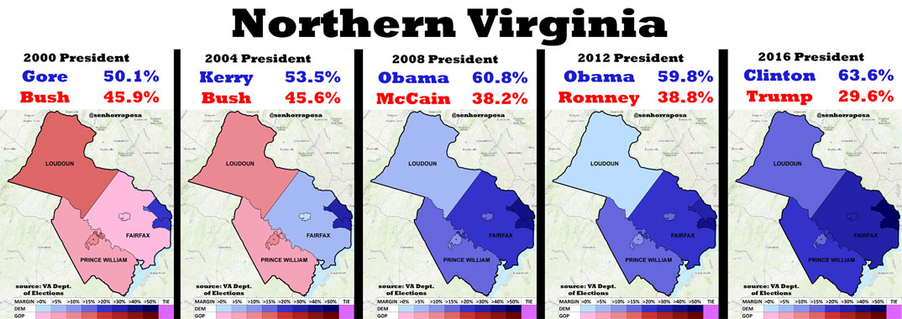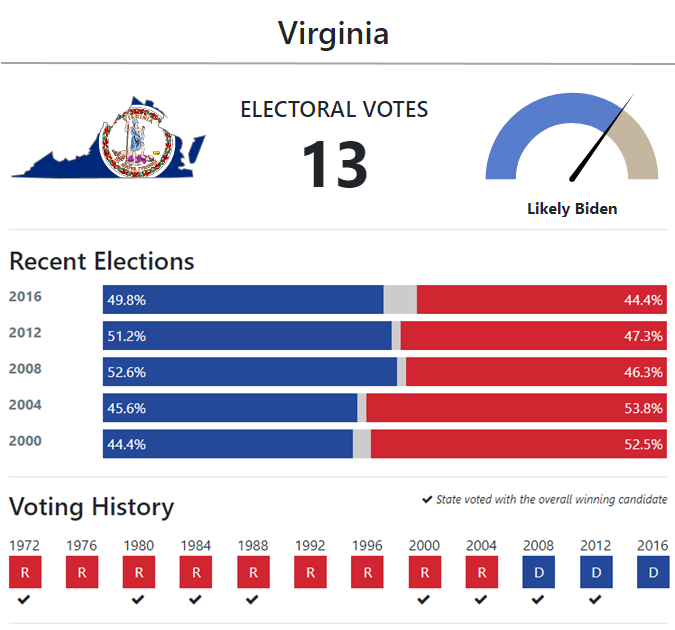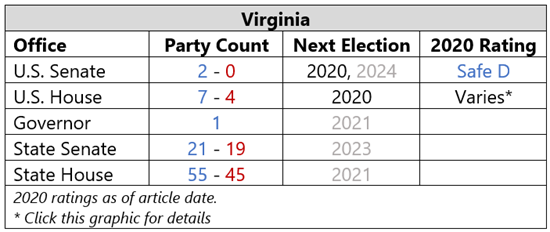The Road to 270: Virginia
By Drew Savicki
July 20, 2020
The Road to 270 is a weekly column leading up to the presidential election. Each installment is dedicated to understanding one state’s political landscape and how that might influence which party will win its electoral votes in 2020. We’ll do these roughly in order of expected competitiveness, moving toward the most intensely contested battlegrounds as election day nears.
The Road to 270 will be published every Monday. The column is written by Drew Savicki, a 270toWin elections and politics contributor. Contact Drew via email or on Twitter @DrewSav.
One of America’s oldest states, the Commonwealth of Virginia has produced eight presidents, more than any other state. Virginia -- home to sites like the historic Jamestown settlement, Thomas Jefferson’s Monticello, and the Appomattox Court House, where Robert E. Lee surrendered to the Union -- has seen American history play out within its borders.
In presidential contests, the Old Dominion occupies a unique niche. In 1976, Democrat Jimmy Carter carried every state in the Old Confederacy, except for Virginia -- those eleven formerly Confederate states haven’t voted uniformly Democratic since Franklin Roosevelt, in 1944. But by 2016, Virginia was the sole state in the Old Confederacy that found itself in the blue column, supporting Hillary Clinton. In fact, it was the only state that her husband lost twice, in the 1990s, that she carried. While other southern states could well join it on the Democratic side this year, Virginia looks poised to stay blue.
A changing Commonwealth
The 21st century has been a period of great change for Virginia -- in two decades, it’s seen nearly a complete political realignment. Across the Potomac from Washington D.C, Northern Virginia (or NOVA) has seen a significant increase in population, and a remarkable turn to the Democrats, in recent years. While it may be tempting to say the suburban shift started with Trump, it has actually been moving in that direction for a while. Let’s look at the shift from 2000 to present. Using a more restrictive definition of Northern Virginia, you can see how much it has changed in the past 20 years.

While the blue trend in NOVA seems to get the most attention, other suburbs throughout the state have followed suit -- while rural parts of the state have drifted rightward. Let’s consider some of the recent congressional races.
Congressional Politics
Today, Democrats dominate the congressional delegation in Virginia. In 2018, Democrats picked up three congressional districts: districts 2, 7, and 10. At the beginning of the decade (after the 2010 elections), Republicans had an 8-3 advantage in the state’s 11-member House delegation. With the help of a mid-decade remap, and a favorable 2018 midterm, Democrats today have a 7-4 edge.
Covering the Hampton Roads and Virginia Beach area is the military-heavy 2nd Congressional District. In 2018, this district saw a contest between two Navy veterans: Democrat Elaine Luria defeated then-Rep. Scott Taylor (R). VA-2 has long had a slight, but persistent, Republican lean. Taylor, after winning the nomination last month, is set for a rematch against Luria -- though originally he began the cycle by running a quixotic bid for the U.S. Senate against Sen. Mark Warner (D). After failing to gain traction in the Senate race, Taylor dropped back down to his old House seat. Although Trump carried this district by three points in 2016, it seems like a plausible Trump/Biden district, so the Virginia-based Sabato’s Crystal Ball rates the race as ‘Leans Democratic.’
VA-7 is anchored in the Richmond suburbs and flipped to Democrat Abigail Spanberger in 2018. This was historically prime GOP territory -- in fact, in 1996, the version of VA-7 that was in place at the time was Bill Clinton’s worst Virginia district. A former intelligence officer for the CIA, Spanberger ran on her national security credentials against staunch conservative Rep. Dave Brat. Brat, a Tea Party Republican, famously came to Congress in 2014 after defeating then-Majority Leader Eric Cantor in the Republican Primary. Cantor's duties as Majority Leader seemed to limit his time in the district and with his internal polls showing him up 34%, he didn't take the race seriously. But Brat, who made immigration a central campaign theme, trounced Cantor by 11%.
After a convention this past weekend, Republicans have nominated state Delegate Nick Freitas, a libertarian-leaning candidate. In 2019, Freitas failed to make the ballot in his reelection campaign but won as a write-in candidate. Spanberger’s fundraising has been excellent and she is generally considered the favorite for reelection. Sabato’s Crystal Ball rates the race as ‘Leans Democratic,’ so Spanberger is the favorite but not prohibitively so.
In NOVA, Republican Frank Wolf held the 10th District from his election in 1980 until his 2014 retirement. Wolf had a mainstream conservative voting record but tended closely to the local needs of his district -- such as working to fund and expand the Metro rail system. He was succeeded by then-state Delegate Barbara Comstock, a Republican who cast herself in a similar mold. Comstock won easily in 2014, 56%-40%, but was a Democratic target in 2016. Trump, with his ‘drain the swamp’ rhetoric, proved to be a poor fit for this area, which is home to many federal employees, and Hillary Clinton carried VA-10 by 10%.
Perhaps with the assumption that Clinton was going to win, VA-10 voters split their tickets for Comstock, who ran as a check on the seemingly inevitable Clinton presidency. Indeed, Comstock carried over 60 Clinton precincts and won by 6% overall in 2016, but as Trump actually won the presidency, her crossover appeal dried up. In 2018, Democrats ran then-state Senator Jennifer Wexton (D). Though a skilled campaigner, Comstock found herself unable to run away from Trump -- she lost by 12%. Now the incumbent, Wexton is the strong favorite to win reelection and the Crystal Ball rates the race as ‘Safe Democratic’.
Another congressional district that is worth watching is the 5th District. VA-5 includes the highly liberal city of Charlottesville, but stretches down into rural Southside Virginia -- as its name implies, this region, home to rural Blacks and working class whites, is the most ‘Deep South’ part of the state. Freshman Rep. Denver Riggleman (R) lost renomination at a party convention to former Campbell County Supervisor Bob Good. Good, a staunch social conservative campaigned against Riggleman’s officiating of a same sex wedding. The Democratic nominee is Cameron Webb, a medical doctor from Charlottesville. Webb, who is Black, has an impressive resume for a first-time candidate, and going into the late June primary, his campaign perhaps got a boost from the national Black Lives Matter movement.
The Crystal Ball rates VA-5 as ‘Leans Republican’ but Webb is an intriguing candidate, as his profile seems well-suited to current political climate. Southside Virginia has trended Republican in recent years, as the Black population has declined, but this is potentially a sleeper race. Ironically, a Webb victory could throw a wrench into Democrats’ plans for redistricting after the Census. There has been talk that Democrats would shore up Spanberger by drawing Charlottesville into her district -- but Webb’s residence in Charlottesville would complicate that.
West of VA-5, two of the other Republican-held districts are in Appalachia. With the decline of the party’s fortunes in suburbia, the Virginia GOP has essentially been relegated to rural areas of the state. This culturally conservative region was once much friendlier to Democrats, but now it’s solid GOP turf. Reps. Ben Cline (R) and Morgan Griffith (R) are in no danger of losing reelection. As Virginia grows bluer, the gap between blue and red Virginia will keep growing. Appalachia might as well be a different state all together -- in fact, West Virginia governor Jim Justice, seemingly in jest, said that he’d welcome any counties willing to secede from Virginia. Despite southwestern Virginia’s red lean at all higher levels of government, local Democrats are still competitive in some races.
Virginia is one of two states where both senators are former governors (the other being New Hampshire). Both regarded as mainstream Democrats, Senators Mark Warner and Tim Kaine each have long histories in the state’s politics.
An Alexandria lawyer, Mark Warner got his start by running against the popular Republican Sen. John Warner (no relation) in 1996. Mark Warner was unsuccessful but parlayed the run into a successful bid for Governor five years later. Warner was mentioned as a presidential contender in 2004, but declined to run, and after leaving office in 2005 with approvals around 70%, he was also seen a potentially part of a national ticket for the 2008 cycle. But instead, Warner ran for Senate. Between his personal popularity and the national blue wave, he easily stomped former Gov. Jim Gilmore (R), who got in the race after his quixotic presidential bid sputtered out.
In the low turnout and anti-Obama 2014 midterm, Warner faced an unexpectedly close result from former RNC Chairman Ed Gillespie. On Election Day, Warner didn’t lead until later in the night, when Fairfax County reported. Something that may have helped Warner’s credibility that year was a cross-party endorsement from his old GOP rival, John Warner (Warner, a moderate Republican, would go on to endorse Hillary Clinton in 2016). Virginia Republicans have not come any closer to winning statewide since their 2014 effort, and Warner is not a serious target of national Republicans -- he should win a third term easily this fall.
Warner’s lieutenant governor, fellow Democrat Time Kaine, would succeed him as Governor in 2005. After leaving office in 2010, Kaine served as DNC Chairman, and then joined Warner in the Senate after the 2012 elections. With an affable, fatherly personality and fluency in Spanish, Kaine rose to national prominence in 2016 when Hillary Clinton tapped him to be her running mate. Though the Clinton/Kaine ticket lost in 2016, Clinton improved on Obama’s 2012 showing in Virginia. With Trump’s unpopularity in the state, and against a weak candidate in then-Prince William County Supervisor Corey Stewart, Kaine cruised to reelection by 16% in 2018.
State level politics
Virginia -- along with Louisiana, Kentucky, Mississippi, and New Jersey -- holds its gubernatorial elections in off years. Virginia is the only state in the nation where governors cannot serve consecutive terms, making the incumbent Ralph Northam (D) ineligible in 2021. State Sen. Jennifer McClellan and state Delegate Jennifer Carroll Foy are already in the race, with former Gov. Terry McAuliffe also eyeing his old seat. With no state having elected a Black woman as Governor, there will be considerable pressure from many in the party for McAulliffe not to run, given that both McClellan and Carroll Foy are African-American. The past decade has been a rough stretch for Republicans: since their 2009 victories, they've lost every statewide election, some 11 in total, and watched both chambers of the legislature flip blue in 2019.
Embattled Lieutenant Governor Justin Fairfax has been silent on his intentions as of late, but it seems likely he is still mulling a bid for the top office. If he does run and is elected Governor, Fairfax would be the Commonwealth's second African-American Governor after Doug Wilder (D).
Going back in time a bit, another example of the pre-Trump suburban swing is the change between 2001 and 2005 gubernatorial races. This swing essentially created the current political map of Virginia. Tim Kaine -- who was the mayor of Richmond before his career in statewide politics -- improved upon Mark Warner in places such as Northern Virginia, the Richmond suburbs, Hampton Roads, and Charlottesville. Meanwhile southwestern Virginia, southside Virginia, and the tidewater regions got more Republican.
_.jpg)
With a potential delay in states receiving their Census Data due to the COVID-19 outbreak, how redistricting will work next year is unclear at the moment. Along with Virginia, New Jersey holds its legislative elections in off years. The Garden State is seeking to delay its legislative redistricting until 2023 as a result. It seems possible Virginia could do the same, so next year's legislative elections would be held under the current maps, which were drawn using the population from the 2010 Census. This would not affect the congressional redistricting though, as neither state has early filing dates for those offices. There's just limited time to draw new legislative maps in time for the election that same year.
Presidential politics and 2020 outlook
Virginia Polls >>
For much of its history, Virginia was part of the solid south. It voted Democratic from statehood until the 1950s with only a few exceptions. Dwight D. Eisenhower’s 1952 victory in Virginia was a realigning election in the commonwealth. The state would vote Democratic just once over the next 56 years, until Barack Obama won the state in 2008.
In 2012, both campaigns targeted Virginia, polls showed a very tight race, and the Crystal Ball actually predicted Romney would win the state in their final projections for 2012. Ultimately though, President Obama carried the state by 4% but since he won the election, the forecast error didn’t get much attention. In 2016, Hillary Clinton carried Virginia by five points and, since then, the state has strongly moved towards Democrats. Polling of the commonwealth this cycle has been scarce and it has not received any attention from the Trump campaign. Trump last rallied in the state in 2016 and avoided holding any rallies for the 2017 or 2018 elections in the state. With the leftward shift of college educated whites, it seems quite unlikely the Trump campaign will be making any play for Virginia’s 13 electoral votes.
Next Week: Colorado
Going forward, we will use the model powering the 2020 presidential election simulator to determine the following week's state. Specifically, we will look at the 'Battleground 270' results of 25,000 simulations run late Sunday afternoon. Of the states remaining, the next to be covered will be that with the highest likelihood of a Trump or Biden win as of that date. View the current state-by-state probabilities in the table at the bottom of the Battleground 270 page.



